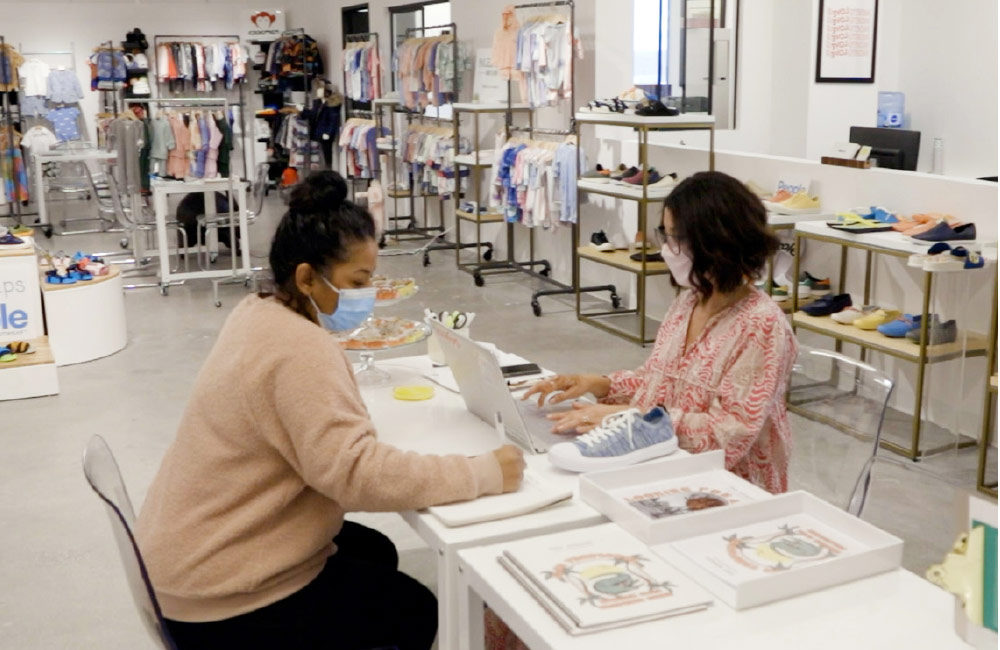With their fingers on the pulse of the childrenswear business, sales reps from across the country step out of their showrooms and into this Earnshaw’s spotlight to discuss the state of the market and what’s ahead for 2022.

Working safely at
In Play.
Showrooms and the sales representatives who run them provide an invaluable business link between childrenswear manufacturers and their accounts. Often behind the scenes, sales reps are creating inviting spaces to best showcase brands, learning the unique needs of manufacturers and retailers, staying up to date on trends, and offering their business expertise that has been built on decades of industry experience. It’s a job that requires a high level of commitment, time and patience.
“Our longtime retail partners trust us to introduce them to brands and products we believe in, and that’s how we pick who we work with,” says Sandra Martinez Roe of In Play. “Our brands depend on us to educate and guide them for a successful launch of a product and/or brand based on our many years of knowledge and partnerships. It is important that what we sell, in the end, sells through.” Allison Moroze, who runs Ali’s Market, concurs about the careful relationship building so that both parties are successful. “I do my best to understand the needs and nuances of my manufacturers/brands. I am not just writing an order—I am establishing trust and a partnership between my manufacturers and the retailers. My job is to bring those two together so everyone gets the best sales they can.”
Showrooms at a Glance
The sales reps featured have more than 125 years of combined experience and a collective passion for what they do. Check them out:
Ali’s Market
Run By: Allison Moroze
Years in Business: 16
Regions: Northeast
Why She Loves Her Job: Selling and helping the retailers meet their needs. “I really like knowing the people behind the brands I work with.”
Cultivated Kids
Run By: Jill Griffith
Years in Business: 27
Regions: Dallas
Why She Loves Her Job: Helping retailers improve their profitability. “The most rewarding aspect for me is the positive things I can make in someone’s business and in turn, thier life.”
In Play
Run By: Sandra Martinez Roe
Years in Business: 15
Regions: Atlanta, Dallas, Los Angeles, New York
Why She Loves Her Job: The connection, her team and her business partner. “We have met some of the most fascinating people, many of whom are our friends. We share life events, swap ideas and encourage each other as we move forward in our careers. We have built a rad team and it is such a pleasure to work with them on a daily basis. My partner-in-crime Hilary and I are such a great combo—we have been able to enjoy some of the best times in our lives together, face wild challenges and strategize solutions.”
Julie Smith Kids
Run By: Julie DeJardin Smith
Years in Business: 25
Regions: Los Angeles
Why She Loves Her Job: Change with new product and customers, working with accounts and building relationships. “I love being in a field where change is always happening. It’s exciting when the season gets introduced with new color palettes, interesting fabrics and hot trends. Change also reflects in our customer base—new babies are always being born and our children continue to grow. I have made valuable relationships throughout the years with boutiques owners, manufacturers’ colleagues, and sales reps.”
Shayna Masino Sales
Run By: Shayna Masino
Years in Business: 29
Regions: Dallas, Los Angeles
Why She Loves Her Job: Creativity, independence, diversity
Summer Place Showroom
Run By: Brittany Harrell
Years in Business: 29
Region: Atlanta
Why She Loves Her Job:
The people, the product and the process. “I love working with my incredible team. It often does not feel like work because it’s so fun to unbox new samples and display everything for market. When it is ‘showtime,’ you can feel the energy and excitement!”
Task Rabbits
Throughout the season, sales reps have a host of tasks for their dual set of clients, according to Julie DeJardin Smith, who runs Julie Smith Kids. For the manufacturers, she stages the space to showcase each collection and connects with established and new stores in the region with the goal of increasing her customer base. Smith has a continuous loop of feedback that helps her “grow the business for each manufacturer and communicate ideas to support and elevate each collection.” When it comes to her accounts, DeJardin Smith’s goals include building a relationship based on support and service, presenting the collections and assisting and servicing each store.
The variety of work and the manufacturer-retailer dynamic is what keeps many reps in the business, year after year. “We wear many hats and most importantly is the ability to give mutual respect for each business and their individual direction,” explains Shayna Masino of Shayna Masino Sales. “I personally love to assist my brands to meet the needs of the market and work with the buyers to make selections that will sell in their stores season after season.”
Less Supply, More Demand
Moving the right product to the right stores hadn’t been an issue until COVID and its ensuing supply-chain disruptions. The growing number of workers, especially in trucking and warehouse jobs who are quitting is partially to blame; the Labor Department in July, reported that the warehouse industry had a record 490,000 job openings. Goods have been stuck in shipping containers, with skeleton crews to get them into port or offload them. The word that’s seemingly on every businessperson’s lips these days is: delay.
The ripple effect of delays is being felt industry-wide. The later the goods arrive in store, the less time they can be sold in season, re-ordering becomes an issue and the cycle starts all over again, according to Jill Griffith of Cultivated Kids who currently has merchandise stuck in L.A. ports. “Everything from factory shutdowns to port delays have hurt our manufacturers and our retailers,” comments Brittany Harrell of Summer Place Showroom. “My accounts are having trouble planning when merchandise will be arriving, and ship dates are all over the place right now.” Masino says that disruptions in the supply chain are causing lack of resources such as fabric and trims. Moreover, The Great Resignation—the voluntary departure of employees from the workforce—continues to wreak havoc on all industries, including childrenswear. “Many retailers, vendors and sales reps are battling a lack of consistent, qualified employees,” Masino reports. DeJardin Smith has heard the same feedback: “Accounts have expressed the main challenge that they have experienced is getting employees to return to work as well as the difficulty of hiring new employees.”
While many of the complex issues are not under anyone’s control, there are some ways to deal with them and make the best of a difficult situation. Masino suggests that vendors produce samples sooner and buyers submit their purchase orders in earlier in anticipation of delays. When it comes to employment shortages for small retailers and her own showroom business, Martinez Roe sees the glass as half full: “The upside is that most of the owners—including ourselves—have had to jump back in to handle the day to day, and we are seeing an increase in business because this is what we know, do and love.”
Web Sales For The Win
The global pandemic has created some permanent shifts in how business is conducted as well as client expectations. Griffith expects virtual appointments and online resources for collections to remain a key part of her showroom’s sales strategy, and Masino says that successful retailers have truly grabbed the social media bull by its horns. “It has been a wild ride, but we have seen some amazing new developments in the in the children’s fashion business,” Masino enthuses. “Boutiques that were teetering on taking their business online did so out of desperation when stores were shut down due to COVID mandates. For many it has been a slow trial and error process, but almost all stores have seen an addition to their business via non-conventional retail. We have seen a major increase in publicity via Instagram, Tik Tok and Facebook groups.”
Roe Martinez agrees and adds that the consumer’s buying habits have changed, for the better. “We believe that shoppers are starting to think of quality, longevity and their own contribution towards their local communities and economies, which is very helpful for our accounts.” DeJardin Smith also witnessed the phenomenon of the local economy, which could very well be here to stay. “Many consumers discovered the value and convenience of shopping the boutiques in their neighborhoods. The stores worked diligently to creatively adjust and thrive. Service, parking, and unique merchandise are amenities consumers realized, supported, and appreciated,” she says. “The pandemic made consumers more aware of shopping local—consumers are kind of ‘rewarding the retailers’ that offered curb-side delivery and home delivery,” says Griffith.
However, one unavoidable downside in the current retail climate, according to Roe Martinez, is that across the board, prices have increased. Interestingly, higher costs may cause a consumer shift to higher quality standards for kids’ clothing and accessories. “I am hoping that the quality over quantity becomes the norm as that is the most sustainable way to approach the future, but we shall see how the consumer reacts.”
These Buyers Went to Market
If the attendance and energy at the last round of regional markets is any indication about buying activity, then 2022 is looking better than ever. Harrell says that “business was extremely strong at the last in person market.” She continues: “Our July 2021 gift market and August 2021 apparel market both set records for us in Atlanta. I think customers were so eager to return to business as usual that they all came to the show.”
Masino reports that markets are slowly returning to normal occupancy. “We are seeing a lot of local regional buyers who use to be serviced by small travel shows go to our LA and Dallas markets, which everyone agrees is a better buying experience. The buyers see more product, can shop and compare, get inspired by industry talks and full displays, and meet and discuss business with fellow buyers.”
Roe Martinez feels “refreshed” by her recent showroom activity in Dallas. “It was so nice to see our shops in person and catch up. I feel like we are all so burnt out on Zooms that our in-person appointments are that much more personal and fun,” she says. “I feel like it connected us all more and has allowed us to bond over the work that goes into running a business, staffing it and balancing our personal lives while doing it.”
Both coasts got rejuvenated. New York City’s Playtime last August was a wonderful success by any standards. Moroze enthuses, “All the manufacturers were eager and excited to be back and the stores—they loved it! We all missed seeing each other, and it brought and energy back we have not seen in years.” In Los Angeles, markets were also well attended, according to DeJardin Smith. “Our markets are slowly returning to normal occupancy, we are seeing a lot of local regional buyers who use to be serviced by small travel shows go to our LA and Dallas Markets, which all agree is a better buying experience. The buyers see more product, can shop and compare, get inspired by industry talks and full displays, and meet and discuss business with fellow buyers.” While virtual showings over Zoom kept everyone afloat from March 2020, there’s nothing that replaces real facetime with customers and the merchandise, says DeJardin Smith. “We all appreciate more than ever the opportunity to see, touch and select the best of the collections for our customers.”
























Leave a Comment: